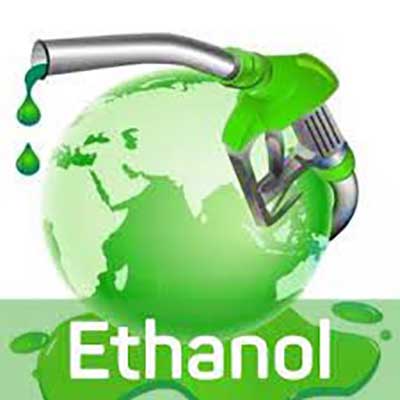Relevance: GS-3: Science and Technology- developments
Key phrases: Ethanol Blending, Bio fuel, E10, E20, Molasses, Min of PNG, Agro Based Product
Why in News?
- India’s surplus sugar stock is likely to come down substantially to less than a million tonne (mt) in next four years from a high of 5.2 mt last year — thanks to the success of the ethanol blending programme with industries diverting sugarcane for direct conversion to the bio-fuel.
What is the Ethanol Blending Programme (EBP)?
- Ethanol is an agro-based product, mainly produced from a by-product of the sugar industry, namely molasses. In years of surplus production of sugarcane, when prices are depressed, the sugar industry is unable to make timely payment of cane price to farmers.
- The Ethanol Blended Petrol Programme (EBP) was launched in 2003. It seeks to achieve blending of Ethanol with motor sprit with a view to reducing pollution, conserve foreign exchange and increase value addition in the sugar industry enabling them to clear cane price arrears of farmers.
Government intervention to increase Ethanol Blending:
The Ethanol Blended Petrol Programme was launched in 2003 with an aim to promote the use of renewable and environmentally friendly fuels and reduce India’s import dependence for energy security.
To increase indigenous production of ethanol the Government since 2014 took multiple interventions like:-
- Re-introduction of administered price mechanism.
- Opening of alternate route for ethanol production.
- Reduction in Goods & Service Tax (GST) on ethanol meant for EBP Programme from 18% to 5%;
- Differential ethanol price based on raw material utilized for ethanol production;
- Interest Subvention Scheme for enhancement and augmentation of the ethanol production capacity by Department of Food and Public Distribution (DFPD);
- For the first time during ethanol supply year 2018-19, following raw materials apart from C heavy molasses were allowed for ethanol production viz. B heavy molasses, sugarcane juice, sugar, sugar syrup, damaged food grains like wheat and rice unfit for human consumption
- The National Policy on Biofuels–2018, provides an indicative target of 20% ethanol blending under the Ethanol Blended Petrol (EBP) Programme by 2030.
- The Union Ministry of Road Transport and Highways has mandated stickers on vehicles mentioning their E20, E85 or E100 compatibility.
- MoP&NG has also issued a 'Long Term Ethanol Procurement Policy' under EBP Programme With a view to achieve 10% ethanol blending in petrol by 2021-22 and 20% by 2030
Advantages of Ethanol Blending:
- Using ethanol-blended petrol for vehicular applications has a lot of benefits. One of them is certainly the reduction in pollution level. Biofuel is known for being a lesser pollutant. This will certainly help in bringing down the pollution level if used on a mass scale.
- India currently imports 85% of its total fuel. This results in a huge bill for crude oil. Using 20% ethanol-blended fuel for vehicles in India means the country will save a lot of money.
- New technology implementation means there will be opportunities for new job creation. The OEMs and their component suppliers and aftermarket service providing segments will witness new job creation.
- The Indian government claims that the target of achieving 20% ethanol in petrol will help the agriculture sector. The government claims that farmers will see increased income because of this policy.
Challenges in Ethanol Blending:
- A new technology implementation on a mass scale certainly requires a huge sum of investment from the industry stakeholders. After spending a huge amount of money on BS-VI migration from BS-IV in record time, it will be hard for the auto industry stakeholders to invest another huge sum. And that too at a time, when the industry has been hit hard by the Covid-19 pandemic.
- Farmers who have been traditionally farming sugarcanes can be benefitted from the strategy. But it is hard to believe that a large scale of farmers will opt for sugarcane farming, which is the main ingredient for ethanol production.
- The timeframe is another challenge. With the Covid-19 and subsequent troubling situations disrupting the auto industry operations, achieving the target by the set deadline could be a real challenge.
- On the occasion of World Environment Day, 5 June 2021,
Hon’ble Prime Minister Shri Narendra Modi released the report of the
Expert Committee on Roadmap for Ethanol Blending in India by 2025.
The committee proposes E-20 roadmap with the following milestones:
- Raise pan-India ethanol production capacity from the current 700 to 1500 crore litres
- Phased rollout of E10(10% blending) fuel by April 2022
- Phased rollout of E20(20% blending) from April 2023, its availability by April 2025
- Rollout of E20 material-compliant and E10 engine-tuned vehicles from April 2023
- Production of E20-tuned engine vehicles from April 2025
- Nationwide educational campaign
- Encourage use of water-sparing crops, such as maize, to produce ethanol
- Promote technology for the production of ethanol from non-food feedstock.
Source: The Hindu BL
Mains Question:
Q. As per recent report India has achieved the highest ever ethanol blending of 8.1 per cent with petrol. In the context what is Ethanol blending? Is ethanol blending in petrol really green? Illustrate.









